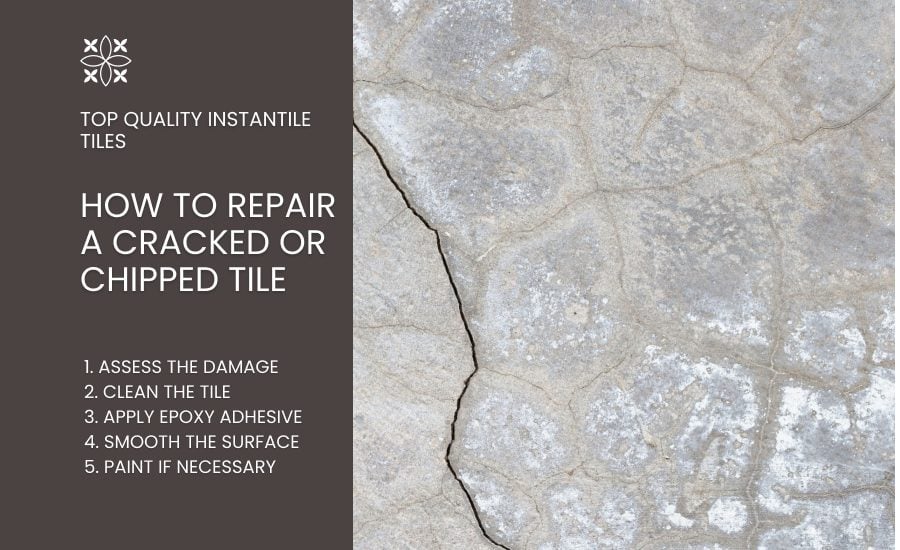How To Repair Ceramic Tile Floors? Key Takeaways
- The ceramic tile repair process includes several steps: cleaning the surface, applying epoxy adhesive, smoothing the tile, and painting it
- Cracks and chips in ceramic tiles can happen due to heavy impact, moisture, or temperature changes
- To repair cracked or chipped tiles, you will need epoxy resin, a putty knife, fine-grit sandpaper, cleaning supplies, matching paint, and gloves
- If your tiles have large cracks, deep chips, edge damage, or discoloration, it might be better to replace them
- To prevent future damage, use furniture pads, clean spills as soon as they happen, and use pH-neutral cleaners
Life’s little accidents can damage even the most durable ceramic floors. So, what do you do when you notice a crack or chip?
Can you fix it yourself?
In this guide, you’ll find:
- How to repair ceramic floors
- What materials you need for the repair
- When to consider tile replacement
- How to minimize the risk of tile damage
How To Repair Ceramic Tile Floors
Chipped or cracked tiles impact the beautiful appearance of your floor or wall. Here’s what you can do.
How to Repair A Cracked Ceramic Tile
When a tile cracks, there appears a visible split or fracture. This could be the result of a dropped plate, structural shifts, or issues with the subfloor.
Cracks can be thin and shallow or wide and deep. Regardless of how they look, they can weaken the tile, and that’s why repair is important.
- Assess the Damage
Start by carefully examining the tile. Is it just a fine hairline crack? If so, a quick repair might do. But if it’s extensive, it’ll be better to go for a replacement.
- Clean the Tile
Remove dust and grime from the cracked area with a cleanser and a soft cloth. Dry the tile so there’s no water left on the surface.
- Apply Epoxy Adhesive
Use a two-part epoxy adhesive and mix the two components as per the instructions on the label. Put a small amount of the adhesive onto the crack with a fine brush, craft stick, or toothpick.
- Smooth the Surface
Smooth out the soft epoxy with a small plastic scraper or a gloved finger, ensuring it’s the same level as the tile.
- Paint if Necessary
If the result is too visible, apply paint that has the color of your tiles.
How to Fix A Chipped Ceramic Tile
A chipped tile has a small piece broken off from its surface or edge. This doesn’t affect its strength but can ruin the aesthetics and lead to more serious damage in the future.
Repairing a chipped tile involves similar steps, but the goal is slightly different:
- With cracks, you’re sealing a line to get a flat surface.
- With chips, you’re rebuilding and reshaping the missing piece at edges and corners.
- Clean the Chipped Area
Clean the surface to make sure there are no loose fragments and dust.
- Fill the Chip
Fill the chipped area, whether surface, edge, or corner chip, with a ceramic tile repair filler or a clear epoxy resin, using a putty knife. This will help you sculpt it in a way that matches the shape of the undamaged tile.
- Shape and Smooth
Press the filler to form the tile’s contour and leave it to dry for as long as the label says.
- Sand and Paint
To make the repaired tile look the same way as the surrounding ones, sand it to a smooth finish and paint it with a matching color.
Pro Tip: Test your paint and filler on a spare tile or a hidden area before touching up to help you achieve the ideal outcome.

The process of repairing a cracked and chipped tile is similar but has a different goal and focus
When To Consider Ceramic Tile Replacement
While it is possible to repair minor chips and cracks, serious damage will call for a tile replacement.
Consider this option if:
- There are large or multiple cracks that affect the strength and appearance of your flooring.
- The crack is so deep that you can see the tile’s base material.
- Damage has affected the corners and edges, making repairs challenging or obvious.
- There are loose or hollow-sounding tiles, which could be a sign of adhesive or subfloor issues.
- You notice discoloration or staining that cleaning or refinishing cannot fix.
Savvy homeowners see beyond surface repairs. For them, replacing tiles isn’t just about looks, but about long-term investment. They opt for newer tile systems to benefit from easy maintenance and lower environmental impact.
How To Prevent Future Damage to Ceramic Floors
You’ve now repaired all the chips and cracks. Now let’s make sure they stay that way with a few smart preventative steps.
- For heavy furniture, use pads to avoid scratching and cracking.
- Clean spills at once to prevent moisture from weakening your tile strength and grout lines.
- Use gentle brushes and pH-neutral chemicals to clean your floor. See our guides on how to clean tile floors, how to clean shower tiles, and our floor tile maintenance guide.
- Seal grout lines to get a protective layer against stains and erosion.
- Be careful when moving heavy objects, as dropping or dragging them can crack, chip, or scratch your ceramic tiles.
Ceramista: Easy and Clean Tile Installation and Repair
Want tiles that last a lifetime with minimum effort for repair? Ceramista has them.
Our ceramic tiles use an INSTANTILE interlocking system that has a twofold advantage:
- It speeds up initial installation up to nine times compared to traditional methods and doesn’t involve glue, grout, or additional adhesives.
- It makes repairs effortless, allowing you to replace a single cracked or chipped tile quickly without affecting the surrounding floor.
What does this mean for you? No dust, no extended downtime, and no extra repair costs.
Whether you drop a heavy vase or host hundreds of guests, Ceramista tiles make repair and maintenance easy and stress-free.
Ceramista offers Spanish quality and beauty, sustainable tiles crafted at Europe’s largest solar-powered production facility, and an exceptional range of style options, from wood-look finishes and terracotta-inspired designs to bold modern patterns.
Enjoy stunning floors with minimal effort with Ceramista.

With Ceramista, you can replace damaged tiles quickly and easily
How To Repair Ceramic Tile Floors? FAQs
If you are looking for more information about repairing your tile floor, check out the answers to frequently asked questions.
Can I repair a tile with a large crack?
If the crack is large, it is best to remove and replace it. Interlocking tiles like Ceramista’s speed up both installation and repair.
Can I buy a ceramic tile repair kit?
Yes, you can buy a ceramic tile repair kit and use it to fix small cracks and chips. In the kit, you’ll find an epoxy filler, colorants, and application tools.
What’s the fastest way to replace a damaged tile?
The fastest way to replace a damaged tile is using an interlocking system like Ceramista’s INSTANTILE. It allows you to change the damaged tile glue and tools, reducing downtime and mess.




